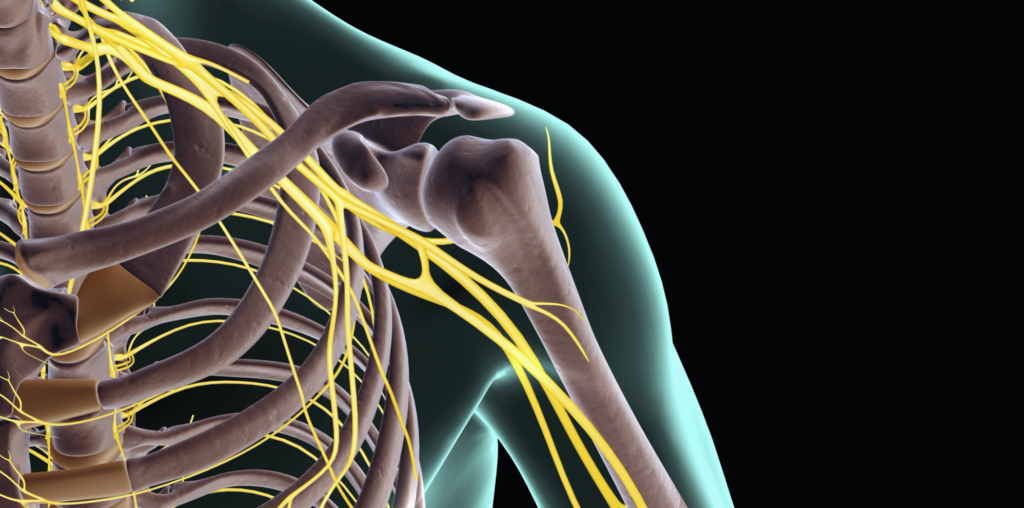BRACHIAL PLEXUS SURGERY

What’s the Brachial Plexus?
The Brachial Plexus refers to a network of nerve fibers that supplies the skin and musculature of the upper limb. It begins in the root of the neck, passes through the axilla, and runs through the entire upper extremity. Formation of this plexus involves the anterior rami (divisions) of cervical spinal nerves C5, C6, C7, C8 and T1.
The brachial plexus divides into 5 parts; roots, trunks, divisions, cords and branches. No functional difference occurs between these parts. These divisions simply aid understanding and visualization of the brachial plexus during surgery.
This plexus gives rise to 5 major branches that supply the upper limb. These include; the musculocutaneous nerve, axillary nerve, radial nerve, ulnar nerve and median nerve. It also gives off minor branches at various levels of its extent. These minor branches include; the dorsal scapular nerve, long thoracic nerve, suprascapular nerve, nerve to subclavius, lateral pectoral nerve, medial pectoral nerve, medial cutaneous nerve of arm, medial cutaneous nerve of forearm, superior subscapular nerve, thoracodorsal nerve, and inferior subscapular nerve.
Brachial Plexus Surgery
The brachial plexus refers to a network of nerves that convey sensory and motor signals from the upper segment of the spinal cord in the neck down to arms and hands. Trauma to the neck and/or shoulder may injure the brachial plexus, causing pain, discomfort, numbness, weakness, or paralysis in the arms or hands.
Some injuries to the brachial plexus heal without any surgical treatment, leaving the individual with normal or near-normal function. In cases of more severe injuries, brachial plexus surgery provides the best chance to relieve pain and restore normal functioning and sensation.
Types of Brachial Plexus Surgery
Brachial plexus surgery aims to relieve pain and restore normal sensation and motor function to the shoulder, arm or hand. Surgical approaches consider the type, location and extent of the nerve injury, as well as overall health and impact of the injury on the patient’s ability to work and quality of life.
Recommended surgical procedures for severe brachial plexus injury include:
- Nerve Grafting Surgery
In the case of an injured or severely scarred nerve, it may no longer have the ability to convey signals from the brain to the upper limb, leading to paralysis. In this case, surgeons can take out the damaged nerve segment and replace it with a dispensable sensory nerve from another part of the body, such as the sural nerve in the lower limb (leg). This procedure, referred to as nerve graft, helps establish a bridge that replaces the injured portion of the nerve and provides a pathway for nerve regeneration.
- Brachial Plexus Nerve Repair
In certain cases of a cut or torn nerve, the surgeon can re-connect this nerve by sewing the torn ends back together. Surgeons perform this surgery with the aid of a microscope and small, specialized instruments.
- Brachial Plexus Decompression and Neurolysis
When a nerve gets compressed but remains intact, a decompression surgery may help relieve the pressure on the nerve and treat related symptoms and loss of function. Surgeons can decompress a nerve by scar tissue removal (a procedure referred to as neurolysis) from around the compressed nerve.
- Nerve Transfer Surgery
During a nerve transfer, the surgeon connects a nearby functioning nerve performing a noncritical function to the injured nerve. This creates a framework for regeneration and a pathway for signals. In many cases, a nerve transfer procedure provides the best chance of restoring motor and sensory functions to the muscles and skin. Nerves that can prove useful in this procedure includes the medial pectoral nerve in front of the shoulder, the intercostal nerve under the ribs, the musculocutaneous nerve in the arm, and many other nerves in the upper limb.
- Tendon Transfer Surgery
During a tendon transfer, the surgeon attaches a functional and expendable tendon (such as the gracilis tendon) to a tendon paralyzed due to a brachial plexus injury. After tendon transfer, the functioning tendon will pull on the once paralyzed tendon to restore lost motor function. In some cases, a tendon transfer offers the best option for restoring movement after a brachial plexus injury. Unlike nerve transfers, tendon transfers can take place anytime after the brachial plexus injury.
Injuries treated with Brachial Plexus Surgery
- Erb’s Palsy
- Klumpke’s Palsy
- Neuromas, schwannomas and neurofibromas
- Cervical radiculopathy
- Carpal tunnel syndrome
- Ulnar nerve palsy
References
https://my.clevelandclinic.org/health/diseases/21986-erbs-palsy
